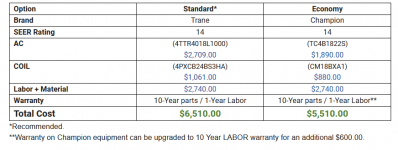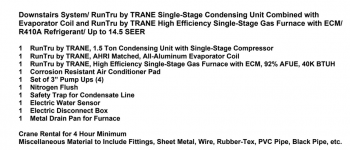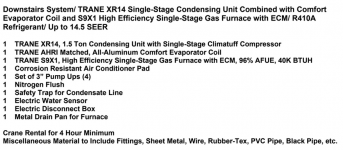GoingMyWay
Member
- Joined
- Oct 11, 2017
- Messages
- 3,782
Our zone 1 (first 2 levels) AC stopped working last summer. We currently have a 14 years old Goodman gas furnace and 1.5 ton AC (running R22). A contractor I emailed estimated that it would cost about $1500 to fix assuming it's a leak in the A coil.
I got these 2 estimates to replace the whole system:
Caffi Services
[attachimg=1]
Trademasters
[attachimg=2]
[attachimg=3]
They're both between $6500-8000 and will require a crane to lift the condenser onto the 4th floor roof.
The zone 2 system is a heat pump and is also 14 years old. 11 years ago I had the A coil replaced. I had actually asked for estimates to replace both systems since a crane is going to be required either way, but that's going to be $16,500 - $18,000. That's too much to spend at one time.
I don't think it makes a lot of sense to fix a 14 year old system. I've heard that Goodman systems only last about 10 years so I feel like we were already running on borrowed time. My friend said I should just fix it since it's significantly cheaper and see how long it lasts, if something else breaks worry about it at that time. $6500-8000 is a lot of money to shell out so $1500 does sound a lot better to me.
My understanding is that a new refrigerant is going to be coming out in 2023 so I wonder if I should wait for that or just go with an R410 system or fix what I have.
Does anyone have any AC system recommendations or local HVAC contractor recommendations in the Northern Virginia area?
Thanks!
I got these 2 estimates to replace the whole system:
Caffi Services
[attachimg=1]
Trademasters
[attachimg=2]
[attachimg=3]
They're both between $6500-8000 and will require a crane to lift the condenser onto the 4th floor roof.
The zone 2 system is a heat pump and is also 14 years old. 11 years ago I had the A coil replaced. I had actually asked for estimates to replace both systems since a crane is going to be required either way, but that's going to be $16,500 - $18,000. That's too much to spend at one time.
I don't think it makes a lot of sense to fix a 14 year old system. I've heard that Goodman systems only last about 10 years so I feel like we were already running on borrowed time. My friend said I should just fix it since it's significantly cheaper and see how long it lasts, if something else breaks worry about it at that time. $6500-8000 is a lot of money to shell out so $1500 does sound a lot better to me.
My understanding is that a new refrigerant is going to be coming out in 2023 so I wonder if I should wait for that or just go with an R410 system or fix what I have.
Does anyone have any AC system recommendations or local HVAC contractor recommendations in the Northern Virginia area?
Thanks!



